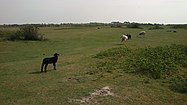Portal:Wetlands/Selected article/19

Beach Meadows are coastal meadows influenced by the presence of the nearby sea.
Under this definition, the salinity of the air and wind is usually high and the meadows are often flooded during and after stormy weather. These conditions implies that the flora is dominated by salt-tolerant species. But that alone does not make a meadow. To be categorized as a meadow in the first place, the plantgrowth has to be low in height, and normally this can only be obtained by traffic or grazing the landscape, either artificially or by livestock. Beach meadows are therefore usually thought of as cultural landscapes or biotopes, requiring some degree of intervention and not being able to sustain itself on its own. If left to their own, beach meadows would transform into a socalled transitional meadow and eventually a shrubby or bushy seashore habitat.
As explained, beach meadows are fundamentally an unstable nature type and this condition have an important influence on the flora and fauna found here. Beach meadows are characterized by a number of plants and animals, that could not have thrived, if the habitat was left to a natural development. The grazing (or traffic) hinders bushes, trees and shrubs to get the upper hand and allows low-growth plants to emerge and dominate. This again attracts and supports a special fauna that would change character, if the beach meadow were left to its own. The specific flora and fauna is of course determined by the general climate and geography of the beach meadow. (Full article...)
